![]()
![]()
![]()
Use LEFT and RIGHT arrow keys to navigate between flashcards;
Use UP and DOWN arrow keys to flip the card;
H to show hint;
A reads text to speech;
7 Cards in this Set
- Front
- Back
|
Where do MHC I antigens occur?
|
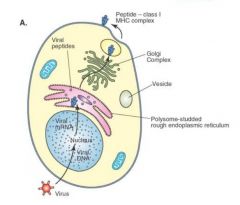
-antigen has to be present in the cytosol of the cell
-most often achieved when the pathogen is intracellular (endogenous antigen), including in the case of most viruses, cancers, and some parasites -since intracellular pathogens, as a group, can invade many different cell types it is essential that MHC I be expressed on a wide variety of cells |
|
|
Where do MHC II antigens occur?
|
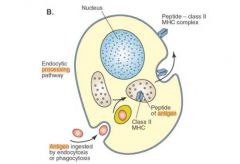
-MHC II presented peptides are produced through antigen procession of antigen that is generally external to the cell (ie. exogenous antigen)
-this type of immune response is particularly effective for pathogens that are living largely extracellularly and are taken up, processed and presented by specialized antigen presenting cells (APC) -this is also the pathway used by B cells when they present antigen taken up through binding of the surface Ig -the antigen processing occurs in specialized intracellular vesicles -most bacteria & parasites are processed this way |
|
|
How are most vaccines delivered, MHC I or MHC II?
|
-most vaccines are delivered as an exogenous antigen and therefore are processed in the MHC II pathway
|
|
|
Describe how MHC class I molecules are synthesized and how antigen is presented
|

-MHC I molecules get synthesized as a membrane associated α-chain in the endoplasmic reticulum and is linked to calnexin
-the β2 microglobulin chain is also present in the endoplasmic reticulum -the calnexin molecule detaches and is replaced by the β2 microglobulin and ERP57/calreticulin and tapasin -this keeps the antigen binding site open -the TAP binds to the tapasin and transfers peptides processed in the cytosol into the endoplasmic reticulum -the peptide that binds into the antigen binding groove, stabilized the MHC I molecule which is now free to migrate through the Golgi to the cell surface where it is exposed to the CD8 T cells |
|
|
Give an example of a virus that interferes with MHC I presentation & how it does this.
|
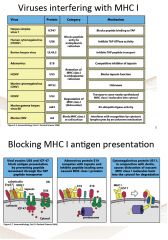
|
|
|
Describe how MHC class II molecules are synthesized and how antigen is presented
|
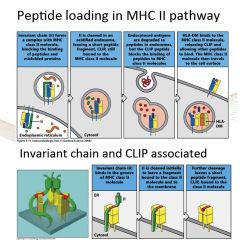
-antigen is taken up by cell through phagocytosis (large antigens) or endocytosis (small antigens)
-the antigen gets degraded in specialized compartments called phagolysosomes, before the chosen peptides are presented on the surface of the antigen-presenting cells in association with MHCII -the MHC II is synthesized as a complex with the invariant chain in the endoplasmic reticulum -this chain helps keeping the MHC II in the correct conformation and prevents binding of self-peptides during synthesis and transport -the invariant chain is a trimer and can bind 3 MHC molecules at the same time -the invariant chain also guides the transport of MHC II out of the ER and through the Golgi apparatus into a vesicles that eventually becomes part of the endocytic pathway by which pathogens and foreign proteins are taken up into the cell -the invariant chain gets degraded by proteases with only a small peptide (CLIP) remaining in the antigen binding groove when the vesicle becomes progressively more acidic -HLA-DM binds the MHC II so that the clip peptide is released making way for freshly degraded lysosomal peptides to bind the MHC II molecule -the loaded MHC molecule is then transported to the surface of the antigen presenting cell |
|
|
What is cross presentation?
|
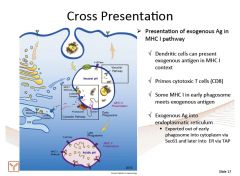
-is a pathway that allows exogenous antigen to be presented in association with MHC I
-exact molecular mechanisms are unclear -it appears that the exogenous antigen is first degraded (at least partially) in endosomal compartment and that these endosomal compartments somehow deliver antigen into the RER -from there the peptides have a chance of getting loaded into the MHC I molecule as if they were transported through TAP |

